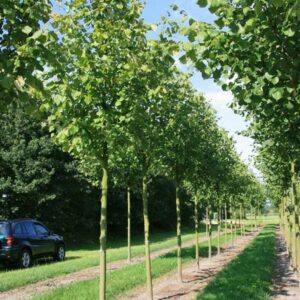Description
General information
Quercus robur
Common oak, English oak
Additive
(= Q. pedunculata) (often flowers earlier than sessile oak, Q. petraea)
WHZ
WHZ 5a
Distribution
Europe, northern Asia Minor. The common oak is a tree native to lowlands and grows in wetlands and low-lying regions, in diverse mixed deciduous woodlands. It is also found in scrub vegetation and hedgerows. In mountain regions it does not grow at high altitudes like sessile oak. On deep, moist, nutrient-rich, calcareous to moderately acid loam and clay soils.
Habit
Very large tree with a broad, high-domed, open crown and generally a short stem and strong branches, asymmetrical, widely spreading and in maturity gnarled and picturesquely twisted.
Size
25 to 35 (40) m in height and 15 to 20 (25) m in spread. Annual growth is 35 cm in height and 25 cm in spread.
Bark
Annual shoots are olive-green at first, later more brown to olive-brown, terminal buds are dome-shaped pointed, up to 7 mm long. Old bark is dark grey to black, deeply fissured.
Leaves
Deciduous, alternate, obovate in outline, towards the base tapering wedge-shaped, base of the leaf-blade is eared, 10 to 15 cm long, with 3 to 6 rounded lobes on each side, slightly leathery, leaves are almost sessile, petioles are 4 (8) mm long, deep green, light green beneath. Autumn colour is a splendid yellow to yellow-brown, leaves are often held on the tree until spring.
Flowers
Yellow-green catkins, 2 to 4 cm long, female flowers in spikes on long peduncles.
Fruits
2 to 3 cm long acorns, stalks are 5 to 12 cm!
Roots
Deep root system, in maturity a shallow spreading root system with plungers. Roots spread throughout the soil, even into deep layers. See Q. petraea.
Site
Sun/light shade.
Soil
Common oaks are generally adaptable to a range of soil conditions. Optimum development is on soils with a high mineral content, deep moist soils, for example heavy clay soils, alluvial soils on floodplains of large rivers and swampy humus soils (EHLERS). Q. robur thrives well on dry normal soils; acid to alkaline.
Characteristics
Frost tolerant, prefers warm sites, demands on the atmospheric humidity levels are less than in the sessile oak (EHLERS), withstands more extreme temperatures than Q. petraea. Q. robur withstands summer droughts even on extreme sites (embankments) without damage (summer ’90), suitable for inner city sites, tolerates smoke, water-logged sites and flooding for up to 3 months (DISTEL 1980), intolerant of alterations to the ground-water table (thinning of the crown), in the last few years an increasing infestation with oak moth and chafer beetles has been noted, shade tolerant when juvenile, wind resistant, sprouts from dormant eyes on old wood (coppice), leaves lower the soil pH value, susceptible to mildew. Common oak can reach the age of 500 to 800 (1000) years. Old trees are prone to lightning-strike.
Utilisations
Solitary, ornamental tree, landscape, roadside plant.






Reviews
There are no reviews yet.